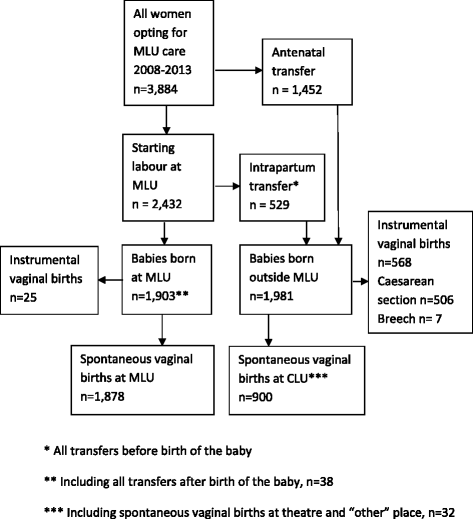Midwife-led maternity care in Ireland - a retrospective cohort study
- PMID: 28351386
- PMCID: PMC5371234
- DOI: 10.1186/s12884-017-1285-9
Midwife-led maternity care in Ireland - a retrospective cohort study
Abstract
Background: Midwife-led maternity care is shown to be safe for women with low-risk during pregnancy. In Ireland, two midwife-led units (MLUs) were introduced in 2004 when a randomised controlled trial (the MidU study) was performed to compare MLU care with consultant-led care (CLU). Following study completion the two MLUs have remained as a maternity care option in Ireland. The aim of this study was to evaluate maternal and neonatal outcomes and transfer rates during six years in the larger of the MLU sites.
Methods: MLU data for the six years 2008-2013 were retrospectively analysed, following ethical approval. Rates of transfer, reasons for transfer, mode of birth, and maternal and fetal outcomes were assessed. Linear-by-Linear Association trend analysis was used for categorical data to evaluate trends over the years and one-way ANOVA was used when comparing continuous variables.
Results: During the study period, 3,884 women were registered at the MLU. The antenatal transfer rate was 37.4% and 2,410 women came to labour in the MLU. Throughout labour and birth, 567 women (14.6%) transferred to the CLU, of which 23 were transferred after birth due to need for suturing or postpartum hemorrhage. The most common reasons for intrapartum transfer were meconium stained liquor/abnormal fetal heart rate (30.3%), delayed labour progress in first or second stage (24.9%) and woman's wish for epidural analgesia (15.1%). Of the 1,903 babies born in the MLU, 1,878 (98.7%) were spontaneous vaginal births and 25 (1.3%) were instrumental (ventouse/forceps). Only 25 babies (1.3%) were admitted to neonatal intensive care unit. All spontaneous vaginal births from the MLU registered population, occurring in the study period in both the MLU and CLU settings (n = 2,785), were compared. In the MLU more often 1-2 midwives (90.9% vs 69.7%) cared for the women during birth, more women had three vaginal examinations or fewer (93.6% vs 79.9%) and gave birth in an upright position (standing, squatting or kneeling) (52.0% vs 9.4%), fewer women had an amniotomy (5.9% vs 25.9%) or episiotomy (3.4% vs 9.7%) and more women had a physiological management of third stage of labour (50.9% vs 4.6%).
Conclusions: Midwife-led care is a safe option that could be offered to a large proportion of healthy pregnant women. With strict transfer criteria there are very few complications during labour and birth. Maternity units without the option of MLU care should consider its introduction.
Keywords: Childbirth; Low-risk pregnancy; MidU study; Midwife-led care.
References
Publication types
MeSH terms
LinkOut - more resources
Full Text Sources
Other Literature Sources
Medical
Research Materials
Miscellaneous


